I am planning on buying a new recorder soon since my pioneer did not get the job done. Is there any new recorders coming out that look good?
+ Reply to Thread
Results 1 to 30 of 40
-
-
You've probably explained this earlier, but what is it that the Pioneer didn't do that you need done? The Pioneer recorders are very full-featured and the soon-to-come DVR-640H-S may be impressive.
-
Basically looking for anything with good quality especially when transfering VHS tapes. I really do not need a hard drive and want something with flex mode recording.
My pioneer suffered from "video signal drop out" from my vcr. I sent it in for repair and they sent it back because they could not duplicate the error. The problem was that it would lose the signal at random times, so they just probably popped a tape in for 1 minute, didn't notice anything wrong and sent it back to me.
-
check the Liteon LVW-1107HC1 at bestbuy its on sale this week for $99.if you don't like it return it
-
Wait until after July 1, 2007 so you can get one with a digital tuner built in.

-
For VHS work, JVC DR-M100S will do excellent.
Want my help? Ask here! (not via PM!)
FAQs: Best Blank Discs • Best TBCs • Best VCRs for capture • Restore VHS -
That was a common issue with the Pioneer 310 and 510 but less of an issue with the 320 and 520. I haven't heard anyone mention it as a problem with this year's 531/533/633 so it may be that Pioneer has fixed the issue since the model you own.Originally Posted by colt4523
From what I've read in various posts the Panasonic recorders are especially good with VHS transfers and I suspect the JVC's also would be good at this. -
Panasonic recorders are especially BAD with VHS due to lack of chroma filters, bitrate inadequacies, and typical encoder issues. It does work well as a pass-through device on damaged tapes, however. Just not as the recorder itself.
Want my help? Ask here! (not via PM!)
FAQs: Best Blank Discs • Best TBCs • Best VCRs for capture • Restore VHS -
Are you referring to the ES10? That's a couple of generations old.Originally Posted by lordsmurf
Picture quality is subjective; everyone has their favorite.
VHS transfers benefit from good TBC performance. I found the Toshiba TBC capability to be the best, while the JVC DR-M100S was particularly intolerant of horizontal jitter and also suffered from false MV detection lockout. -
I second the Toshiba. I started with the D-R4 and liked it so much I upgraded to the RD-XS54. Just a couple of things I don’t like with it. The TV Guide (programming) does not work with satellite. The replacement (RD-XS55) does. The XS54’s TV Guide works with cable and antenna only. For satellite recording, you have to manually set a record start/end time, date, and so on. There is no easy, simple way to make the recorder stop recording after a certain amount of time either. Most recorders let you push the record button multiple times to record in 30 minute increments (30, 60, 90…) when performing a manual record. Not this one. However, this model is awesome as far as picture quality and functionality; especially since the price drop. I picked one up for $325.00 and the functionality and PQ by far outweigh the handful of inadequacies. I will never buy another DVR without a hard drive.
I own a JVC DR-M100 also. I bought this unit because of the fantastic captured frames (still pictures) and the rave reviews on this forum. However, viewing the actual recordings on a TV tells the whole story. This unit has very good filtering and seems to keep more detail (very slight margin when zooming in on a captured frame) at the expense of creating a picture that is lighter and slightly washed out. This can be corrected with a proc amp and a detailer for the most part, but why purchase extra equipment when the Toshiba’s do an outstanding job by themselves? The major problem is the JVC does not adjust the input black level. Everything I recordered with the JVC was substantially lighter than the source. I spent way more than I should have for a proc amp and detailer just to compensate. I wish I would have purchased the Toshiba first. I will be putting the JVC on eBay soon because the more I compare the video each produces, the more I like the Toshiba because the pictures are more like the original source and not softened. But just as Davideck said,Mine used to be the JVC.“Picture quality is subjective; everyone has their favorite”. -
I've never had this problem with my unit, nor others that I have seen. However, very recently I've come across discs made by two units that had "problems". At first glance, it appears the cable box output was the actual culprit, or other similar issues. Few people ever have this problem, so it's more likely some sort of secondary issues. At worst, it's a random error on some JVC units. Something is unusual here, but it's not a typical problem, and it's actually not likely related to the JVC itself. There are other factors at play.Originally Posted by jeffshead
I hope to have more tests done on these units, owners' cooperation permitting.Want my help? Ask here! (not via PM!)
FAQs: Best Blank Discs • Best TBCs • Best VCRs for capture • Restore VHS -
Do the Toshibas have flex mode? That was definitely one feature I liked about the Pioneer.
-
How can it be anything but the JVC? I have tried several different sources; whether it is cable, satellite, PC, or different VCR’s, the results are the same. I also replaced all of the cables and I tried coax, composite and s-video. None of those changes made any difference what so ever and it does not matter which DVD player I use to play the discs. However, the output of the DR-M100 seems to be minutely darker than any of my recorders/players so the JVC recordings look a little better when played back on the JVC recorder. But the recordings are still too light, colors are slightly dull, and slightly washed out overall. Not at all close to the source as compared to the recordings made by five other DVD recorders that I have owned. And I’m not referring to artificial “enhancements” that some recorders add which some people find favorable.Originally Posted by lordsmurf
Don’t mistake what I am saying. The pictures are not at all unwatchable. It’s just very frustrating when the source is near perfect and you waste time on recordings that look washed out as compared to the original source. Of course the utilization of a proc amp remedies the problem satisfactorily, but it should not be necessary to use such equipment. And you know I'm not the only one who is having this issue because other users have posted the same problem on this forum and you have replied to them in the same manner.
Anything is possible. Maybe there is something wrong with my JVC and others could have the same problem. The only true test would be to record the same source with my JVC and with yours and compare the results of both. That’s just not feasible since I’m not going to ship my JVC to you. What kind of testing do you propose? -
Take a look at the pic. You can set to just about any bitrate.Originally Posted by colt4523
Excerpt from RD-XS54 Owners Manual

-
Here's a neat trick for JVC DVD recorder owners that really like the recorded image quality these units produce, especially when recording VHS or analog TV signals... but don't want to invest in a professional type proc amp to deal with source black level adjustments -
Get an open box Toshiba D-R4 off of eBay and use it to pass through your video source to the JVC recorder. In other words, use the Toshiba D-R4 as your frame sync/proc amp device. You can usually get one on eBay for less than $100 shipped (sometimes way less than that).
The D-R4 has an input black level adjustment that works very well. In the DVD Recorder Operation section of the setup menu, you can select Input Black Level... "Standard" is for all NTSC analog video sources (7.5 IRE black level) like VHS, 8mm, Hi8, laserdisc, cable or satellite box, TV tuner, etc. This setting stretches the black level down by -7.5 IRE automatically, while maintaining the original source luma levels. The "Enhanced" input black level setting applies no correction at all and would be used only for 0 IRE analog video sources (like the s-video output of consumer digital camcorders, which are typically 0 IRE).
On the output side of the D-R4, there are several more picture adjustments that are active during signal pass through. In the Picture/Audio Settings section of the D-R4 setup menu, there is an output black level setting, plus there are variable brightness, contrast, color, tint and gamma adjustments, and an edge enhancement (sharpness) adjustment to boot!
When passing a video signal through the D-R4 to a JVC DVD recorder (or other DVD recorders that do not compensate for 7.5 IRE black level sources, like the Lite-On units for example), set the D-R4's Output Black Level to "Enhanced". This removes the 7.5 IRE output black level setup and will send the JVC a 0 IRE black level signal, resulting in a correctly recorded DVD. You can also use the additional adjustments in the Custom Picture Settings to tweak the source image even further.
The D-R4 is an excellent recorder, but lacks the video noise filtering that the JVC has. Using the D-R4 as a pass through proc amp allows you to adjust the source image and compensate for 7.5 IRE black level sources, while doing the actual recording with the JVC produces a really nice DVD with much of the grain and chroma noise removed. The pass through image quality of the D-R4 is outstanding, making it an excellent proc amp. -
I'm wanting to assemble a test disc of recordings, but it won't be anytime soon. For those that see or think they see a problem, everything from wires to sources to inputs has to be accounted for and put through a process of elimination.Originally Posted by jeffshead
Few people ever do an intelligent process of elimination, they just point fingers at something easy. That's another testing obstacle.
For a test like this, you have to assume the machine is 100% fine. Then try to find where else the problem is. It may very well lead back to the unit being the problem, but you cannot test for it if you assume this on first guess. RARELY is the unit actually at fault (regardless of the product), but instead other mitigating issues. You cannot rush either, it may take days or weeks to peg down the issue. So many people want to find the problem in 2 minutes.
I'll get back to you someday, if you want.Want my help? Ask here! (not via PM!)
FAQs: Best Blank Discs • Best TBCs • Best VCRs for capture • Restore VHS -
Agreed, the JVC recordings look nothing like my satellite. It can't be blamed on cables or any other lame excuse. I've used a half a dozen other recorders with the same sat and cables in the same location and none of them have the poor contrast, dulled colors and too soft picture of the JVC.Originally Posted by jeffshead
-
colt4523,
I’m not trying to steer you to one brand or another. I’m simply trying to save you time and money. I could care less about brand name. I want the best imagery with the least amount of headaches.
You may like the imagery of the JVC more than that of the Toshiba. Zooming in on the still imagery is a nice test to see how each recorder filters the image, but the proof is in the pudding. You just are not going to know which machine suites you the best until you see the motion pictures for yourself. Captured frames do not tell the whole story. I admit the stills from the JVC are cleaner and preserve more detail in most (not all) circumstances. But the motion picture (that the stills were captured from) looks washed out no matter what machine plays back the recordings.
If you want your recordings to match the source as close as possible I cannot recommend the JVC unless you follow Gshelley’s recommendation or purchase a proc amp. I can use my proc amp and detailer and make the JVC images look very close to the originals. Actually make them look better. But no matter how much adjusting I do with the proc amp and the detailer, some colors still do not match. I don’t have this issue with the Toshiba. Please understand the JVC’s picture is very good if you use a proc amp and will be acceptable to most everyone but the point I’m trying to make is that the Toshiba also gives you a very good picture without the hassle. Some even argue the Toshiba recordings are superior. Again, personal taste.
As you can no doubt see, I have gone through the process of elimination. Step by step I might add. I got to the point where I wanted the best possible picture so I purchased over a thousand dollars worth of equipment to compensate for my JVC’s short comings. The still images look cleaner than the Toshiba’s in some areas but not in all. As far as viewing the motion pictures, I have to say I like the Toshiba’s. The colors are truer and the overall imagery appears more detailed. When I use the proc amp and detailer with the Toshiba, the results are absolutely awesome. One more thing, the Toshiba also does a decent job of filtering the source to remove grain.
Forgot to mention the Pioneers look really good too. But I don't own one. -
JVC DVD recorders do not compensate for 7.5 black level sources. They are not alone in this... the new Sony RDR-GX315 doesn't, either. Neither do any of the Lite-On machines, or the Lite-On clones like ilo and Gateway. All the Toshiba DVD recorders prior to the "4" series (D-R4, XS34, XS54) likewise did not have any black level adjustments and did not correctly record 7.5 IRE sources. Same with Panasonic DVD recorders prior to the DMR-Ex5 series models. The older Panasonic units had no black level compensation for 7.5 IRE sources, either. Virtually none of the lower cost DVD recorders out there (Emerson, Symphonic, RCA, etc.) have any black level adjustments.
Here's what happens when you record a 7.5 IRE black level source with the JVC (or any DVD recorder that does not compensate for 7.5 IRE)... the black level on the recorded DVD will be a little too light - Note that all the grabbed frames were taken with VirtualDubMod and saved to JPG for viewing on computer displays.
JVC DVD recorder, s-video in, source DVD playback at 7.5 IRE black level:
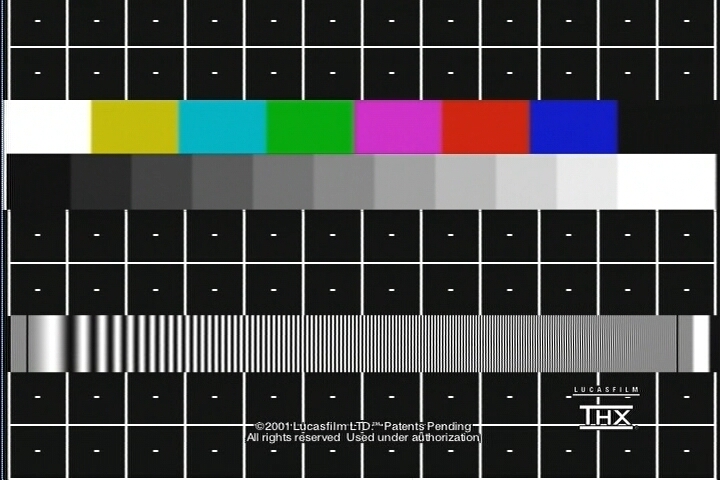
When the source video signal is at 0 IRE, the recording turns out fine -
JVC DVD recorder, s-video in, source DVD playback at 0 IRE black level:
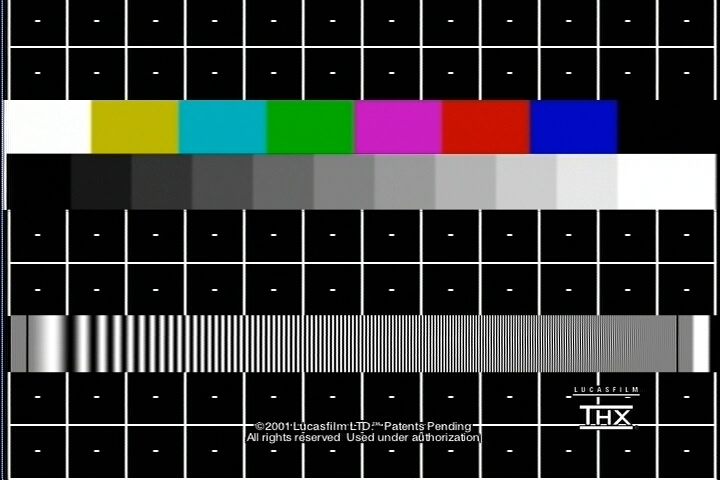
Here's the original frame from the THX test disc for comparison:
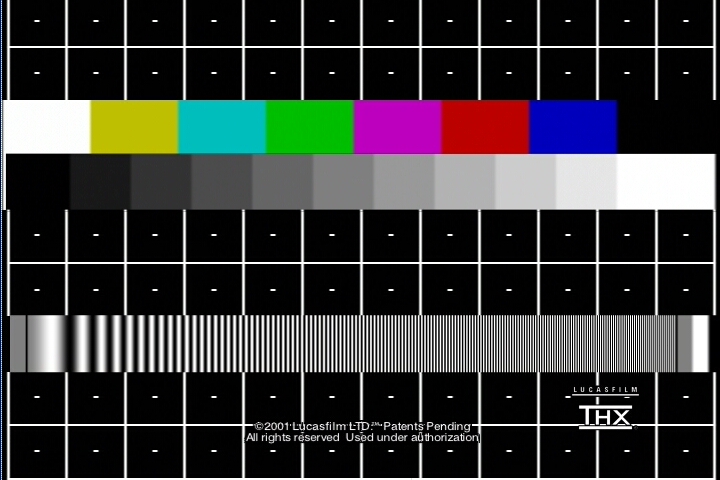
-
Of course it's the JVC.Originally Posted by lordsmurf
It was demonstrated by the images in this thread, and at that time you suggested that it was a good thing...
https://forum.videohelp.com/viewtopic.php?p=1486581#1486581
Originally Posted by lordsmurf -
Another thing worth mentioning is rarely are source correct to begin with. TV sets are wrong. DVD players are wrong. This war is a lot bigger than just DVD recorders. Everything is off to some degree.
Want my help? Ask here! (not via PM!)
FAQs: Best Blank Discs • Best TBCs • Best VCRs for capture • Restore VHS -
Here's another real world example. I recorded a clip from an old Star Wars laserdisc with my JVC DVD recorder. The first one is my Pioneer CLD-D704 laserdisc player composite video output directly to my JVC DVD recorder. The second one is being passed through a Toshiba D-R4 to compensate the black level as I described in the post I made earlier in this thread.
LD player directly into JVC DVD recorder:
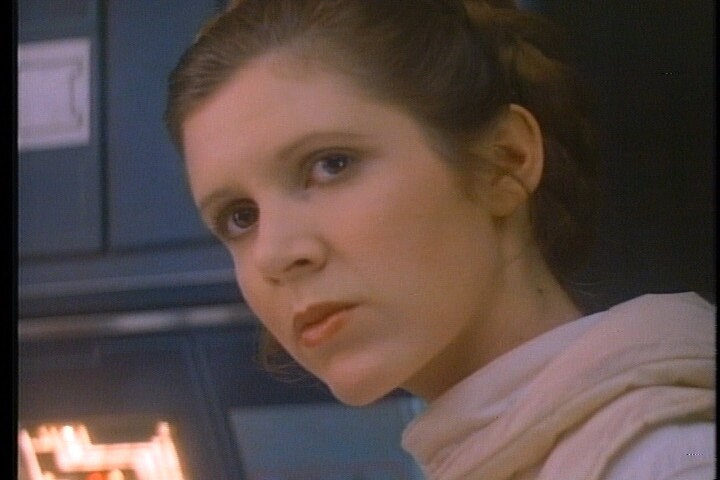
LD player passing through the D-R4 for black level compensation, then to the JVC:
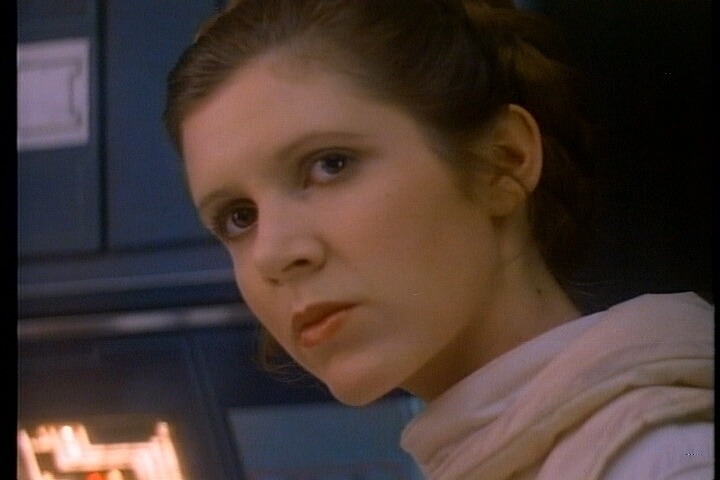
I also tweaked the source image slightly with the D-R4 by turning on the edge enhancement. Between the corrected black level and the mild sharpening provided by the D-R4, and the video noise reduction applied by the JVC DVD recorder, the second recording looks pretty good. I also used the s-video output of the D-R4, letting it do the Y/C separation (I ran the composite out of my LD player into the D-R4).
This method of using a Toshiba D-R4 as a pass through proc amp will work for any DVD recorder that does not compensate for 7.5 IRE black level sources, of which there are many. I know lots of you have those "specially modified" Lite-On DVD recorders... this would work perfectly for those units. -
I’m going to put my last two cents in. One must see the actual motion picture of the source and of the recordings from each player to really appreciate the differences. I bought the JVC based solely on the stills and recommendations on this site. Mind you I’m not complaining!!! I just can’t stress enough that examining the still caps is not enough to determine the degree of detail, black level, and the overall appearance of the picture each machine produces. Looking at the StarWars caps Gshelley posted, I would probably choose the first one as my favorite because the later looks too dark at first glance when it actually is not. Also, a lighter picture gives the illusion of being more detailed because you can see more lines or objects in the shadows that may be missed in a darker recording. If you throw in a cap of the source, I’m sure the second cap is closer to the original. The point is it can be a little deceiving when only comparing stills. I hope no one takes this the wrong way, all this info and the caps are very useful. I’m just trying to say the still caps may look great but when you actually play the video, you may change your mind about the decision you made based on the still caps alone. Of course the only way around this is to watch a recording made by each recorder and there really is no way to do that unless we all make recordings from the same source (same pieces of equipment) and mail each other the recordings. Not gonna happen.
-
The truth is, as lordsmurf has already mentioned, every video source and piece of video equipment and every video display varies... so it is difficult to come up with perfect analog to DVD transfers. For example, the old Star Wars LD doesn't look that great to start with and the image could probably use more tweaking (like a luma boost and some minor color adjustments), but based strictly on the black level the second cap is closer to what commercial DVD's look like. When you play back the first one in a regular DVD player hooked up to a normal TV, the blacks are a dark gray... definitely a little to light. It's noticeable. The second cap looks much better on a normal TV than the first one. Plus, converting MPEG2 stills to JPG files for viewing on a typical PC monitor seems to throw off the blacks a bit, too. How they look on your monitor will vary.
You are right about motion being the key. You really have to make test recordings in the time length modes that are typical (like 2 hours) and then have a look at how the DVD recorder handles motion, video noise, color, etc. They do vary, and some are better at certain things than others. -
I couldn't agree more. What a screen cap looks like and what the actual recordings being played back on a much larger screen look like are a big difference. I've noticed that the pause on the Toshiba doesn't look as good as the actual playback looks, so if people are pausing to get the caps, it's not a very good indication of actual playback quality. It's a lot harder to see flaws on a 17" to 23" or whatever size monitor people use than on a 27" to 60" TV screen.
-
Does the Toshiba D-R4 have the same time base corrector that the Toshiba D-XS34 has? I think the D-R4 says it has 2D noise reduction while the D-XS34 says it has 3D noise reduction. Is this important?
-
@ all members here..
Could you all please properly lable your equipment (and pics) and as you
go along in your posting of your reports (pics, etc) ??
It would be nice and consistant, and others could follow the same path.
I dont' know what unit you all have, because some of you go through many
of them pretty fast
For instance, I have a Pioneer CLD-V2600 laserdisc player
Also, can someone with these two dvd recorder Brand perform a similar
test (so that others might do their own) with an easily managed equipment
setup, in an effort to rule out the various oddities that seems to be
causing some confusion as to quality of these Brand units.
In other words, I'd like to see the two brand recorders in a head-to-head
test on various source materials for general purpose analysis, using the
JVC DR-M100 vs. the Toshiba D-R4. I'd like to
observe this color issue that is being seen as the single blame for going
with another brand unit.
It is my belief that the DR-M100 is the champ here, but some feel that the color
output, seeing as negative, is outwayed by the D-R4's performance
in this "color" area.
If this is the case, than the deciding factor would probably have to rely on
the final destination..
** A) - Source -to- DVD Recorder -to- media disk
** vs.
** B) - source -to- DVD Recorder -to- 2nd'ary post processing -to- media disk
If A) then perhaps D-R4 would work better in the long run,
otherwise, B) would be better, because you correct the issue with the color
during the post-processing stage.
-vhelp 3950 -
Slightly off topic... but would a jvc recorder work better with a jvc vcr? I ask this because I hooked up 2 different model jvc vcrs to my pioneer and both vcrs experienced the "signal loss". Has anyone heard of Pioneer recorders having trouble with jvc vcr's?
Back on topic
Do the toshibas without the hard drive offer flex mode? (Assuming the pic provided by jeffshead is the bitrate settings for hard drive units)
Similar Threads
-
ReactOS: The Russians Are Coming, The Russians Are Coming (Maybe?)
By CobraPilot in forum ComputerReplies: 12Last Post: 17th Sep 2011, 00:21 -
The Second Coming of jeex
By jeex the II in forum Off topicReplies: 9Last Post: 22nd Oct 2010, 22:47 -
Google TV coming
By jagabo in forum Latest Video NewsReplies: 3Last Post: 21st May 2010, 16:21 -
Stand alone recorders; more of a problem than PC recorders?
By videobruce in forum DVD & Blu-ray RecordersReplies: 24Last Post: 13th Nov 2009, 12:27 -
When is V3 coming???
By mbmapit in forum SVCD2DVD & VOB2MPGReplies: 23Last Post: 1st Nov 2008, 18:11




 Quote
Quote